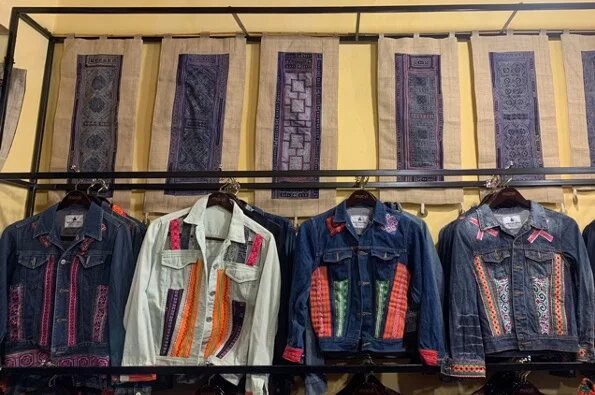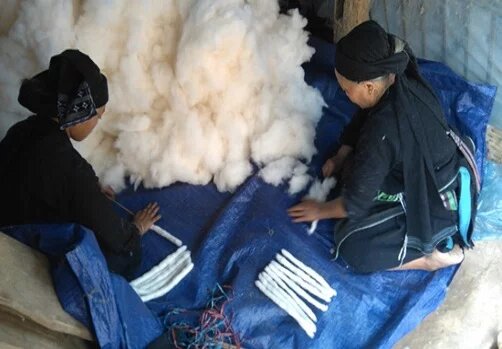
In Vietnam, a dynamic fashion evolution is underway, where indigenous textiles, traditional craftsmanship, and eco-friendly practices are reshaping the creative landscape. This eco-fashion movement, driven by both cultural pride and environmental consciousness, bridges the past and present. Indigenous artisans are key collaborators, transferring knowledge to designers. Vietnam's eco-fashion not only redefines the nation's identity but also aligns with global sustainability trends, offering a harmonious blend of tradition and innovation on the fashion runway.

If you were to visit any highland tourist town in Vietnam or simply wander around Hanoi's Old Quarter, it's quite likely that you'd come across numerous stores selling clothing and accessories adorned with intricately patterned textiles created by indigenous minorities, often referred to as "ethnic minorities" in Vietnam. Much like in other multi-ethnic Southeast Asian countries, the incorporation of indigenous textiles into Western clothing or the national dress has become a common strategy in Vietnam to promote tourism and express a unified multicultural nationhood.
However, over the past decade, the presence of ethnic minority textiles in Vietnamese fashion has evolved beyond the typical "cut-and-paste" approach of using ready-made patterned fabrics. It now places greater emphasis on the technical and material aspects of indigenous textile practices. Prioritizing the use of natural materials and traditional handcrafting techniques, which had long been overshadowed by modern mass production, this movement has increasingly prompted designers and creatives to collaborate with indigenous groups who have preserved these practices. Given its apparent contradiction with the state's agenda of industrialization and modernization over the past few decades, one might wonder: What has triggered this apparent return to nature and the past, and what implications does it hold for Vietnam's creative economy?
Vietnam's Indigenous Eco-fashion and Its Participants
In Vietnam, indigenous textiles have transcended their original local use in a tourism-oriented trade since the mid-1990s when highland areas were reopened for international tourism following the 1986 Economic Renovation, also known as Đổi Mới. Ready-made patterned fabrics are sold either as traditional dresses or incorporated into Western clothing items to better suit the needs of tourists, who are primarily foreigners and Kinh Vietnamese (Vietnam's ethnic majority). However, the shift towards focusing on the material and technical aspects of indigenous textiles did not gain significant momentum until the mid-2010s. Natural materials, including fibers and dyes, have become emblematic of eco-fashion, and the handcrafted techniques required to process these materials add a cultural dimension to it.
Handwoven cotton and hemp, often produced on a small scale by various indigenous groups, have gained popularity, as has the practice of natural dyeing. Dyes sourced from botanical, entomic, and mineral origins are considered more environmentally friendly and healthier than synthetic dyes, and dyeing techniques offer potential for versatile knowledge transfer and application. Therefore, dyestuffs such as indigo leaves, dye yam root, and lac resin have garnered unprecedented interest from both fashion designers and consumers.
Similar to their Western counterparts, Vietnamese fashion designers, concerned about the environmental and social consequences of the global fashion industry, have been seeking creative inspiration and sustainable materials as a solution to these issues. Many opt to revisit what they perceive as existing traditions within the country, finding their answers in the indigenous minority communities that continue to create textiles from natural materials using traditional techniques passed down through generations. A growing community of young amateur craftspeople and fashion enthusiasts actively participates in this movement, despite their lack of professional training in the fashion industry.
Many of these individuals are educated young people who have grown up in cosmopolitan urban environments but find solace in a closer connection to nature. For them, engagement in eco-fashion is part of a broader commitment to a sustainable, environmentally conscious lifestyle that also encompasses green consumption, do-it-yourself practices, and permaculture.
Indigenous artisans play a pivotal role in this movement due to their knowledge and expertise. In addition to selling ready-made patterned textiles, many indigenous artisans have started collaborating more closely with designers. When Kinh designers and creatives visit them to learn the art of natural dyeing, these artisans become their teachers, guides, and eventually partners.
A common scenario involves Kinh designers and craft enthusiasts visiting indigenous artisans, particularly Hmong individuals, to learn the intricate process of indigo dyeing, which requires fermentation and an extended period of learning and practice. Indigenous artisans also apply the patterning techniques used in their traditional clothing to create new patterns based on designers' visions. For instance, the Hmong's batik, or beeswax resist-dyeing technique, is widely learned and utilized due to its versatility and relative ease of mastery compared to other methods.
Many indigenous designers have expanded their branding focus beyond ethno-cultural heritage to encompass ecological sustainability. Unlike Kinh designers who prioritize a multicultural national identity in their branding, indigenous designers tend to express a transnational ethnic identity by connecting with their diasporic co-ethnics in other Southeast Asian countries, China, and even some Western nations. This transnationalism is most evident in the case of Vietnamese Hmong designers, who primarily cater to a diasporic Hmong clientele in Western countries.
First Catalyst: Cultural Nationalism
The resurgence of Vietnamese fashion featuring indigenous textiles can be interpreted as a manifestation of (multi-)cultural nationalism—a response to the growing influence of Western cultural hegemony and a desire to assert a distinct national identity in the face of globalization. Since opening up to globalization, Vietnam has grappled with the challenge of adopting Western values and powers while safeguarding its cultural heritage, giving rise to a national anxiety commonly encapsulated in the motto "to integrate without disintegrating" (hoà nhập mà không hoà tan).
The surge in the number of Vietnamese studying abroad after the 1986 Reform has exposed the younger generation to life within the Global North's cultural sphere. Many repatriates returning to Vietnam after their time abroad feel a renewed sense of national pride, which finds expression through cultural consumption. The emergence of "local brands" in the past decade, Vietnamese fashion labels that emphasize Vietnamese excellence through materials and creative departures from foreign influences, exemplifies this demand for "consumption nationalism." Indeed, some designers in the eco-fashion movement view their choice of indigenous textiles as a means to counter the fashion hegemony of the Global North, industrialized capitalism, and the dominance of Chinese imported fabrics in the market.
Drawing parallels with Vietnam's historical experience of industrialization and colonialism, these designers perceive the "return" to pre-industrial, nature-based local practices as an affirmation of Vietnamese "tradition." Since indigenous minorities are considered integral parts of Vietnam's multi-ethnic nation-state and seen as the custodians of a traditional past, they become ideal candidates for inclusion in this project of (multi-)cultural nationalism.
Second Catalyst: Environmentalism
Another social phenomenon propelling the shift towards indigenous textiles is the rise of environmentalism in Vietnam. Over the past decade, increased access to information has significantly heightened public awareness and concerns regarding ecological issues. Vietnam's economic growth has also empowered its expanding middle class to pay more attention to their consumption choices beyond basic necessities. Their ethical considerations regarding the environment have led to a surge in green consumption across various aspects of life. For instance, the growing number of stores and brands specializing in organic, chemical-free local produce paradoxically corresponds with the proliferation of supermarkets as a normalized option for grocery shopping.
Specifically within the fashion realm, the exposure of the industry's social and environmental impacts through mass media, such as the documentary "The True Cost" (2014), has sparked widespread interest among Vietnamese designers in adopting sustainable and eco-friendly practices. Responding to the public's increasing environmental consciousness, these designers are addressing the growing demand for green consumption. Their search for sustainable materials and practices has led them to collaborate with indigenous artisans who possess expertise in natural materials and traditional craftsmanship.
For indigenous artisans, their role in eco-fashion both reinforces and challenges public perceptions. While ethnic minorities have long been associated with nature in the public imagination, previously seen as reliant on the environment and lacking civilization, their relationship with nature has now transitioned from being viewed negatively (as uncivilized and environmentally detrimental) to a more positive light (as traditional and sustainable).
Conclusion
In summary, the integration of indigenous artisans and their practices into Vietnam's contemporary fashion landscape can be viewed as an intersection of nationalism and environmentalism. The concept of indigeneity is not confined solely to the natural environment but also encompasses the cultures derived from it. The use of natural materials through indigenous practices positions the environment as an integral part of the nation. Given that indigenous minorities are recognized as integral components of the multi-ethnic Vietnamese nation-state and are seen as living preservers of a traditional heritage, they offer an ideal avenue for articulating nationhood through nature. This effectively unites nationalist and environmentalist agendas, with designers' creativity serving as the adhesive that binds these elements together—a development that aligns with Vietnam's endorsement of the creative economy as a path towards sustainable national development.
__
Chi Yen “Ichi" Ha (she/they) is currently a PhD student in Cultural Anthropology at University of California, Riverside (UCR). She holds an MA in Southeast Asian Studies from UCR (2022) and a BA in International Studies/Cultural Psychology from Trinity College, Connecticut (2016). Her research foci include indigeneity and ethnicity, textile materiality, creative economy, posthumanism, political ecology and political ontology, and ethnic minority movements in Vietnam. She has also been working as a consultant for NGOs and civil organizations related to ethnic minority issues in Vietnam.
This article comes from her MA research on artisan-designer collaborations surrounding indigenous textiles in Vietnam, which examined public representations of indigenous artisans in the creative economy. Building on this work, her current research investigates the material and discursive entanglements of indigenous artisans, (mainly Kinh) designers, and materials in natural-dyeing collaborations in Vietnam’s eco-fashion movement.
The views expressed in this article are not necessarily those of Heinrich Böll Stiftung.
This article is a part of web-dossier "Vietnam in Motion", a collaboration between Phuong Phan and Heinrich-Böll-Stiftung Southeast Asia Regional Office.



